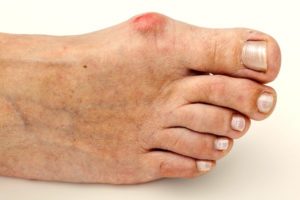 Medically known as Hallux Abducto Valgus (HAV), the term ‘bunion’ describes a bony bulge that can develop over time on the inside of the big toe. The bulge is caused by a malaligned position of the big toe joint where the long bone (metatarsal) moves out towards the other foot and the connecting toe (phalanx) bends in on it, toward the other toes.
Bunions tend to progressively worsen in ‘stages’ and become more prominent. As they do, the ligaments and tissues surrounding the joint stretch and contract accordingly, ultimately leaving the joint in a fixed position. Bony and arthritic changes can also occur within the joint. This means that bunions have different characteristics at different stages and the right management needs to be decided on a case-by-case basis.
Medically known as Hallux Abducto Valgus (HAV), the term ‘bunion’ describes a bony bulge that can develop over time on the inside of the big toe. The bulge is caused by a malaligned position of the big toe joint where the long bone (metatarsal) moves out towards the other foot and the connecting toe (phalanx) bends in on it, toward the other toes.
Bunions tend to progressively worsen in ‘stages’ and become more prominent. As they do, the ligaments and tissues surrounding the joint stretch and contract accordingly, ultimately leaving the joint in a fixed position. Bony and arthritic changes can also occur within the joint. This means that bunions have different characteristics at different stages and the right management needs to be decided on a case-by-case basis.
What causes bunions?
Causes of bunions are numerous and vary greatly. Anything that squeezes or puts greater pressure and force through the big toe joint, like pointed shoes, may be a potential contributing factor. Often bunions can run in the family, are more prevalent in women than men, and are thought to be linked with an unstable function at the big toe joint. Other contributing factors include:- Ill-fitting footwear
- Regularly wearing high heels
- Flat feet
- Increasing age
- History of injury to the big toe joint
- Arthritic conditions
What are the signs and symptoms?
The biggest sign is the change in appearance (protrusion) of the big toe joint. You may also experience:- Redness
- Swelling
- Pain in the big toe joint
- Thickened skin around the big toe joint
- Pain on bending the toe
What is the treatment?
As bunions progressively worsen over time, starting treatment early is the key! If you’ve started noticing your bunion developing either recently or within the last couple of years, now is the best time to take action.We start by identifying the extent of the changes in the big toe joint. A treatment plan can then be implemented to reduce symptoms and limit future progression. Biomechanical and alignment issues will be identified. Periodic evaluation and x-rays may be advised or in some cases observation of the bunion is sufficient. Depending on the characteristics of your bunion, you may benefit from some of the following:- Mobilisation techniques
- Strapping and/or padding
- Bracing
- Specific stretching and strengthening exercises
- Appropriate footwear – high heels and pointed toe shoes are not recommended and will aggravate the condition
- Orthoses (typically depending on if a biomechanical cause is identified)








